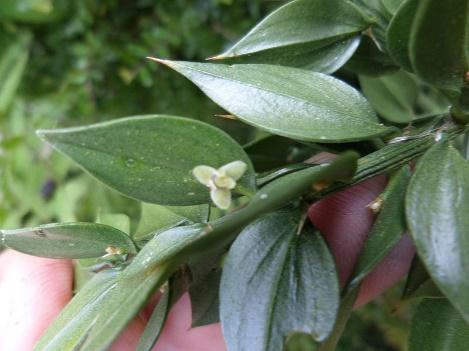
In Ruscus, the stem is a
A. Phyllode
B. Cladode
C. Offset
D. Sucker
Answer
455.7k+ views
Hint:-Stem is modified in plants to perform different functions such as storage of food, for support, for protection or even vegetative propagation in some cases. These modifications can be of different shapes and sizes. It can be present underground, aerial or even sub-aerial.
Complete Answer:-As mentioned above, the stems in various plants have been modified greatly for different functions. Let us see the different modifications of stem mentioned above in the question and see a few examples for it.
First is phyllode. Phyllode is not exactly a stem modification. Phyllode is a petiole that is modified like a leaf. The leaves in the plants that contain phyllode are mostly reduced and the phyllode takes over the functions of the leaf. The examples for plants with phyllode are Acacia spp. and Daviesia spp.
Next, we will talk about cladodes. Cladodes are the stem modifications in which the stems become flattened and assume the functions of the leaves. The leaves are either present as scales or highly reduced. Cladodes are seen in plants like Ruscus, Asparagus etc.
The next is offset. Offset is a short runner with one internode length. Offsets are generally found in aquatic plants like Pistia, water hyacinth etc. They act like vegetative propagules.
The last option is sucker. Sucker is a stem modification which arises from the base of a stem. It develops roots and shoots later act like vegetative propagules. The examples of plants showing suckers are banana plant and apple.

The correct answer is option B – cladode.
Note:- In mosses, there are phyllodes present which are the leaf-like structures. It is present in the gametophytic stage and not considered leaves because they lack vascular tissues.
Cladodes are a type of phylloclade which only has one internode.
Complete Answer:-As mentioned above, the stems in various plants have been modified greatly for different functions. Let us see the different modifications of stem mentioned above in the question and see a few examples for it.
First is phyllode. Phyllode is not exactly a stem modification. Phyllode is a petiole that is modified like a leaf. The leaves in the plants that contain phyllode are mostly reduced and the phyllode takes over the functions of the leaf. The examples for plants with phyllode are Acacia spp. and Daviesia spp.
Next, we will talk about cladodes. Cladodes are the stem modifications in which the stems become flattened and assume the functions of the leaves. The leaves are either present as scales or highly reduced. Cladodes are seen in plants like Ruscus, Asparagus etc.
The next is offset. Offset is a short runner with one internode length. Offsets are generally found in aquatic plants like Pistia, water hyacinth etc. They act like vegetative propagules.
The last option is sucker. Sucker is a stem modification which arises from the base of a stem. It develops roots and shoots later act like vegetative propagules. The examples of plants showing suckers are banana plant and apple.

The correct answer is option B – cladode.
Note:- In mosses, there are phyllodes present which are the leaf-like structures. It is present in the gametophytic stage and not considered leaves because they lack vascular tissues.
Cladodes are a type of phylloclade which only has one internode.
Recently Updated Pages
Master Class 12 Business Studies: Engaging Questions & Answers for Success

Master Class 12 English: Engaging Questions & Answers for Success

Master Class 12 Social Science: Engaging Questions & Answers for Success

Master Class 12 Chemistry: Engaging Questions & Answers for Success

Class 12 Question and Answer - Your Ultimate Solutions Guide

Master Class 12 Economics: Engaging Questions & Answers for Success

Trending doubts
Which are the Top 10 Largest Countries of the World?

Differentiate between homogeneous and heterogeneous class 12 chemistry CBSE

What are the major means of transport Explain each class 12 social science CBSE

What is the Full Form of PVC, PET, HDPE, LDPE, PP and PS ?

What is a transformer Explain the principle construction class 12 physics CBSE

Explain sex determination in humans with the help of class 12 biology CBSE




